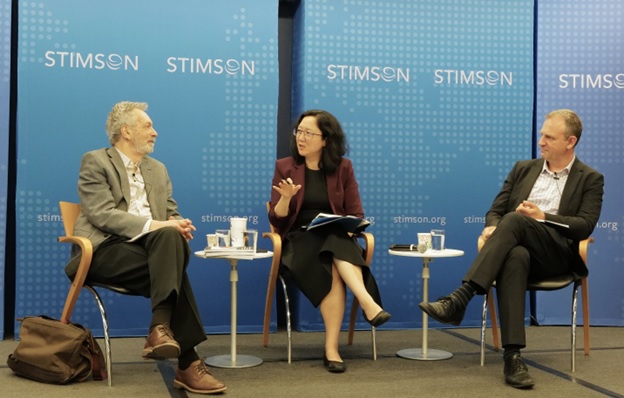

Left to right: Gilbert Rozman, Yun Sun, and Sergey Radchenko
Stimson Center Spotlights Russia-China-US Complex Relationship
By Elaine Pasquini
Photo by Phil Pasquini
Washington, DC: Relations between China and Russia are presently a popular topic among think tanks and policy institutes, along with how the United States fits into this relationship. Increasingly, US-China relations are becoming more competitive, while Beijing and Moscow grow closer.
Stimson Center senior fellow Yun Sun, co-director of the East Asia program and director of the China program, moderated a lively discussion on these issues at the Stimson Center on April 23, 2025.
Sun pointed out that China has a strong energy dependence on Russia which last year supplied about 20 percent of the country’s crude oil import. Beijing is confident about its long-term alignment of interest with Moscow, as they see many common factors that will bring the two countries together.
Noting that the United States could seek a closer alignment with Russia in order to counter China, Sun asked Sergey Radchenko, professor at Johns Hopkins School of Advanced International Studies, his view on this triangular relationship.
China, Radchenko responded, does want to build up its strategic partnership with Russia which the Chinese see as being in their interest and something they would like to strengthen.
For years, the People’s Republic has had an ongoing relationship with Russia who it sees as an important partner that will allow them to kind of serve as a lightning rod for American pressure. The idea was the Russians being an ally would “protect China in important ways,” he argued.
“Those ideas that today we would say provide a kind of ideological foundation for a closer Sino-Russian relationship are not ideas that Putin and Xi Jinping brought into this relationship,” Radchenko stressed, “but ideas that have been formulated over years and decades, so this is why this relationship is fundamentally quite healthy and strong.”
Economic issues are an underestimated aspect bringing China and Russia together, he added. “This is not a competitive relationship economically. Russia provides oil and gas. China provides machinery, electronics and consumer goods.”
As an example, Radchenko pointed out that the Chinese have made great inroads into the Russian automobile market after the exit of Western, South Korean and Japanese car manufacturers. “So, it’s a very beneficial relationship.”
Currently, China is Russia’s top trading partner with bilateral trade at more than $240 billion. While this is leverage, it’s not realistic leverage, he said, and China understands this and “will not be dictating to Russia about anything.”
Economically, politically and regionally, in terms of border issues, this is actually a very good relationship and if you look at this relationship from Russia’s point of view you want to have a good relationship with China, this “massive country right next door” and “an important economic partner,” he said.
Gilbert Rozman, professor at Princeton University, argued that Xi Jinping’s vision for Asia is one of Sinocentrism which he described as “a sort of a concealed strategy or identity of what China has in mind. It’s a civilizational perspective; it’s a hierarchical perspective; it doesn’t take sovereignty that seriously when it comes to certain territorial and cultural themes.”
According to the professor, Sinocentrism had an important role to play in the history of Sino-Soviet relations and in the breakup of China’s rejection of Japan’s efforts to steer regionalism in the late 80s and early 90s. “But Xi Jinping adds a special touch to it,” he said. “He is more explicit about the China dream, regaining China’s role in the world and particularly in Asia.”
Over time, China’s approach to its neighborhood became more assertive, he continued. It sought to develop the Silk Road economic belt as a challenge to Russia’s hesitancy about cooperating fully in Central Asia.
Rozman attributed the recent tensions in the China-Russia relationship to Sinocentrism and Russian weariness and nervousness when it comes to identity issues and Central Asia where China has made some significant inroads. “There is also the question of whether Russia and China can keep the upswing in their relationship when Kazakhstan and Central Asia post a problem, and China, despite its relative deference to Russia, is still driven by a Sinocentric logic and in various cases, whether in North Korea or the Polar Silk Road, there is some sense that what China wants may not correspond to what Russia is willing to offer,” he opined.
Sun interjected that China’s Belt and Road Initiative was launched in Kazakhstan and questioned whether the Russia-China competition, therefore, will play out more vigorously in Central Asia and if the region is drifting more towards China than Russia.
Rozman acknowledged that China is gaining in Central Asia. “The C5+1 group means China has its own direct contact with Central Asia apart from Russia,” he said. “But this is a complicated situation because China is concerned about going too far in pushing Russia into some negative response.”
In closing, Sun noted her observation during her recent visit to Beijing that the strategic Chinese community believe that Russians are too direct and too confrontational when instead there are opportunities to exert influence in more subtle ways.
“The Chinese analogy is that the Russians are boxers – very direct, confrontational; and the Chinese style is Tai Chi – it’s circling around and then influencing you from behind,” she explained. “But that’s an interesting analogy or comparison of the different strategic cultures.”
(Elaine Pasquini is a freelance journalist. Her reports appear in the Washington Report on Middle East Affairs and Nuze.Ink.)

